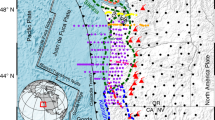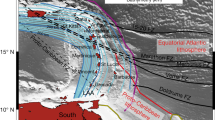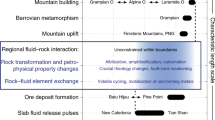Abstract
Water within the oceanic lithosphere is returned to Earth’s surface at subduction zones. Observations of metamorphosed veins preserved in exhumed slabs suggest that fluid can escape via channel networks. Yet, it is unclear how such channels form that allow chemically bound water to escape the subducting slab as the high pressures during subduction reduce the porosity of rocks to nearly zero. Here we use multiscale rock analysis combined with thermodynamic modelling to show that fluid flow initiation in dehydrating serpentinites is controlled by intrinsic chemical heterogeneities, localizing dehydration reactions at specific microsites. Porosity generation is directly linked to the dehydration reactions and resultant fluid pressure variations force the reactive fluid release to organize into vein networks across a wide range of spatial scales (μm to m). This fluid channelization results in large-scale fluid escape with sufficient fluxes to drain subducting plates. Moreover, our findings suggest that antigorite dehydration reactions do not cause instantaneous rock embrittlement, often presumed as the trigger of intermediate-depth subduction zone seismicity.
This is a preview of subscription content, access via your institution
Access options
Subscribe to this journal
Receive 12 print issues and online access
$259.00 per year
only $21.58 per issue
Buy this article
- Purchase on Springer Link
- Instant access to full article PDF
Prices may be subject to local taxes which are calculated during checkout





Similar content being viewed by others
References
Peacock, S. M. Fluid processes in subduction zones. Science 248, 329–337 (1990).
Walowski, K. J., Wallace, P. J., Hauri, E. H., Wada, I. & Clynne, M. A. Slab melting beneath the Cascade Arc driven by dehydration of altered oceanic peridotite. Nat. Geosci. 8, 404–408 (2015).
John, T. et al. Volcanic arcs fed by rapid pulsed fluid flow through subducting slabs. Nat. Geosci. 5, 489–492 (2012).
Katayama, I., Terada, T., Okazaki, K. & Tanikawa, A. Episodic tremor and slow slip potentially linked to permeability contrasts at the Moho. Nat. Geosci. 5, 731–734 (2012).
Hacker, B. R., Peacock, S. M., Abers, G. A. & Holloway, S. D. Subduction factory-2. Are intermediate-depth earthquakes in subducting slabs linked to metamorphic dehydration reactions? J. Geophys. Res. 108, B1, 2030 (2003).
Spence, W. Slab pull and the seismotectonics of subducting lithosphere. Rev. Geophys. 25, 55–69 (1987).
van Keken, P. E., Hacker, B. R., Syracuse, E. M. & Abers, G. A. Subduction factory: 4. Depth-dependent flux of H2O from subducting slabs worldwide. J. Geophys. Res. 116, B01401 (2011).
Garrison, T. S. Oceanography, An Invitation to Marine Science Vol. 2 (Thomson Brooks/Cole, 2010).
Manga, M. et al. Changes in permeability caused by transient stresses: field observations, experiments, and mechanisms. Rev. Geophys. 50, RG2004 (2012).
Ingebritsen, S. E. & Manning, C. E. Permeability of the continental crust: dynamic variations inferred from seismicity and metamorphism. Geofluids 10, 193–205 (2010).
Ague, J. J. & Rye, D. M. Simple models of CO2 release from metacarbonates with implications for interpretation of directions and magnitudes of fluid flow in the deep crust. J. Petrol. 40, 1443–1462 (1999).
Manning, C. E. & Ingebritsen, S. E. Permeability of the continental crust: implications of geothermal data and metamorphic systems. Rev. Geophys. 37, 127–150 (1999).
Miller, J. A., Cartwright, I., Buick, I. S. & Barnicoat, A. C. An O-isotope profile through the HP-LT Corsican ophiolite, France and its implications for fluid flow during subduction. Chem. Geol. 178, 43–69 (2001).
Selverstone, J. & Sharp, Z. D. Chlorine isotope constraints on fluid-rock interactions during subduction and exhumation of the Zermatt-Saas ophiolite. Geochem. Geophys. Geosyst. 14, 4370–4391 (2013).
Spandler, C., Pettke, T. & Rubatto, D. Internal and external fluid sources for eclogite-facies veins in the Monviso Meta-Ophiolite, Western Alps: implications for fluid flow in subduction zones. J. Petrol. 52, 1207–1236 (2011).
Breeding, C. M. & Ague, J. J. Slab-derived fluids and quartz-vein formation in an accretionary prism, Otago Schist, New Zealand. Geology 30, 499–502 (2002).
Herms, P., John, T., Bakker, R. J. & Schenk, V. Evidence for channelized external fluid flow and element transfer in subducting slabs (Raspas Complex, Ecuador). Chem. Geol. 310, 79–96 (2012).
Rüpke, L. H., Morgan, J. P., Hort, M. & Connolly, J. A. D. Serpentine and the subduction zone water cycle. Earth Planet. Sci. Lett. 223, 17–34 (2004).
Padron-Navarta, J. A. et al. Fluid transfer into the wedge controlled by high-pressure hydrofracturing in the cold top-slab mantle. Earth Planet. Sci. Lett. 297, 271–286 (2010).
Scambelluri, M., Müntener, O., Hermann, J., Piccardo, G. B. & Trommsdorff, V. Subduction of water into the mantle—history of an Alpine peridotite. Geology 23, 459–462 (1995).
Hoogerduijn Strating, E. H. H. & Vissers, R. L. M. Dehydration-induced fracturing of eclogite-facies peridotites—implications for the mechanical-behavior of subducting oceanic lithosphere. Tectonophysics 200, 187–198 (1991).
Scambelluri, M., Strating, E. H. H., Piccardo, G. B., Vissers, R. L. M. & Rampone, E. Alpine olivine-bearing and titanian clinohumite-bearing assemblages in the Erro Tobbio peridotite (Voltri-Massif, NW Italy). J. Metamorph. Geol. 9, 79–91 (1991).
Messiga, B., Scambelluri, M. & Piccardo, G. B. Chloritoid-bearing assemblages in mafic systems and eclogite-facies hydration of Alpine Mg-Al metagabbros (Erro-Tobbio Unit, Ligurian Western Alps). Eur. J. Mineral. 7, 1149–1167 (1995).
Chollet, M., Daniel, I., Koga, K. T., Morard, G. & van de Moortele, B. Kinetics and mechanism of antigorite dehydration: implications for subduction zone seismicity. J. Geophys. Res. 116, B04203 (2011).
Perrillat, J. P. et al. Kinetics of antigorite dehydration: a real-time X-ray diffraction study. Earth Planet. Sci. Lett. 236, 899–913 (2005).
Eggler, D. H. & Ehmann, A. N. Rate of antigorite dehydration at 2 GPa applied to subduction zones. Am. Mineral. 95, 761–769 (2010).
Arkwright, J. C., Rutter, E. H., Brodie, K. H. & Llana-Funez, S. Role of porosity and dehydration reaction on the deformation of hot-pressed serpentinite aggregates. J. Geol. Soc. Lond. 165, 639–649 (2008).
Rutter, E. H., Llana-Funez, S. & Brodie, K. H. Dehydration and deformation of intact cylinders of serpentinite. J. Struct. Geol. 31, 29–43 (2009).
Fusseis, F. et al. Pore formation during dehydration of a polycrystalline gypsum sample observed and quantified in a time-series synchrotron X-ray micro-tomography experiment. Solid Earth 3, 71–86 (2012).
Tenthorey, E. & Cox, S. F. Reaction-enhanced permeability during serpentinite dehydration. Geology 31, 921–924 (2003).
Bach, W. et al. Unraveling the sequence of serpentinization reactions: petrography, mineral chemistry, and petrophysics of serpentinites from MAR 15° N (ODP Leg 209, Site 1274). Geophys. Res. Lett. 33, L13306 (2006).
Plümper, O., Røyne, A., Magrasó, A. & Jamtveit, B. The interface-scale mechanism of reaction-induced fracturing during serpentinization. Geology 40, 1103–1106 (2012).
Connolly, J. A. D. Computation of phase equilibria by linear programming: a tool for geodynamic modeling and its application to subduction zone decarbonation. Earth Planet. Sci. Lett. 236, 524–541 (2005).
Emmanuel, S. & Ague, J. J. Impact of nano-size weathering products on the dissolution rates of primary minerals. Chem. Geol. 282, 11–18 (2011).
Auzende, A.-L. et al. Deformation mechanisms of antigorite serpentinite at subduction zone conditions determined from experimentally and naturally deformed rocks. Earth Planet. Sci. Lett. 411, 229–240 (2015).
Kawano, S., Katayama, I. & Okazaki, K. Permeability anisotropy of serpentinite and fluid pathways in a subduction zone. Geology 39, 939–942 (2011).
Connolly, J. A. D. & Podladchikov, Y. Y. Compaction-driven fluid flow in viscoelastic rock. Geodin. Acta 11, 55–84 (1998).
Connolly, J. A. D. Devolatilization-generated fluid pressure and deformation-propagated fluid flow during prograde regional metamorphism. J. Geophys. Res. 102, 18149–18173 (1997).
Bons, P. D. The formation of large quartz veins by rapid ascent of fluids in mobile hydrofractures. Tectonophysics 336, 1–17 (2001).
Morgan, J. P. & Holtzman, B. K. Vug waves: a mechanism for coupled rock deformation and fluid migration. Geochem. Geophys. Geosyst. 6, 8 (2005).
Dragovic, B., Baxter, E. F. & Caddick, M. J. Pulsed dehydration and garnet growth during subduction revealed by zoned garnet geochronology and thermodynamic modeling, Sifnos, Greece. Earth Planet. Sci. Lett. 413, 111–122 (2015).
Angiboust, S., Pettke, T., de Hoog, J. C. M., Caron, B. & Oncken, O. Channelized fluid flow and eclogite-facies metasomatism along the subduction shear zone. J. Petrol. 55, 883–916 (2014).
Vrijmoed, J. C. et al. Metasomatism in the ultrahigh-pressure Svartberget garnet-peridotite (Western Gneiss Region, Norway): implications for the transport of crust-derived fluids within the mantle. J. Petrol. 54, 1815–1848 (2013).
Jung, H. & Green, H. W. Experimental faulting of serpentinite during dehydration: implications for earthquakes, seismic low-velcoity zones, and anomalous hypocenter distributions in subduction zones. Int. Geol. Rev. 46, 1089–1102 (2004).
Jung, H., Green, H. W. & Dobrzhinetskaya, L. F. Intermediate-depth earthquake faulting by dehydration embrittlement with negative volume change. Nature 428, 545–549 (2004).
John, T. et al. Generation of intermediate-depth earthquakes by self-localizing thermal runaway. Nat. Geosci. 2, 137–140 (2009).
Kelemen, P. B. & Hirth, G. A periodic shear-heating mechanism for intermediate-depth earthquakes in the mantle. Nature 446, 787–790 (2007).
Chernak, L. J. & Hirth, G. Syndeformational antigorite dehydration produces stable fault slip. Geology 39, 847–850 (2011).
Proctor, B. & Hirth, G. Role of pore fluid pressure on transient strength changes and fabric development during serpentine dehydration at mantle conditions: implications for subduction-zone seismicity. Earth Planet. Sci. Lett. 421, 1–12 (2015).
Prieto, G. A. et al. Seismic evidence for thermal runaway during intermediate-depth earthquake rupture. Geophys. Res. Lett. 40, 6064–6068 (2013).
Parai, R. & Mukhopadhyay, S. How large is the subducted water flux? New constraints on mantle regassing rates. Earth Planet. Sci. Lett. 317, 396–406 (2012).
Holland, T. & Powell, R. A Compensated-Redlich-Kwong (CORK) equation for volumes and fugacities of CO2 and H2O in the range 1 bar to 50 kbar and 100–1600 °C. Contrib. Mineral. Petrol. 109, 265–273 (1991).
Padron-Navarta, J. A. et al. Tschermak’s substitution in antigorite and consequences for phase relations and water liberation in high-grade serpentinites. Lithos 178, 186–196 (2013).
Viti, C. & Mellini, M. Mesh textures and bastites in the Elba retrograde serpentinites. Eur. J. Mineral. 10, 1341–1359 (1998).
Dodony, I. & Buseck, P. R. Serpentines close-up and intimate: an HRTEM view. Int. Geol. Rev. 46, 507–527 (2004).
Dohmen, R. & Milke, R. in Reviews in Mineralogy Geochemistry (eds Zhang, Y. & Cherniak, D. J.) 921–970 (2010).
Acknowledgements
The paper greatly benefited from discussions with H. E. King, H. Austrheim, B. Jamtveit, L. Rüpke, P. Meakin, C. Spiers, M. Drury and A. Latini. T.J. and M.S. acknowledge discussion within the EU Early Stage Training Network ZIP (Zooming In between Plates, FP7-PEOPLE-2013, 604713) and thank the European Commission for funding. O.P., T.J., Y.Y.P. and J.C.V. acknowledge their interdisciplinary discussions as members of PGP without which this project would never have been realized. We thank W. Bach for the IODP samples and J. Ague. We also thank A. Schreiber (GFZ Potsdam) for preparing FIB cuts. O.P. was supported through a Veni grant (863.13.006), awarded by the Netherlands Organisation for Scientific Research (NWO). J.C.V. was supported by the European Research Council (ERC) starting grant MADE-IN-EARTH (335577). Y.Y.P. acknowledges support from CADMOS (Center for Advanced Modelling Science).
Author information
Authors and Affiliations
Contributions
All authors participated in collecting the data and interpretation of the results; O.P. and T.J. collected and interpreted the microstructural and chemical data: O.P., T.J., J.C.V. and Y.Y.P. developed the final model together; T.J. and M.S. did the field work and first petrological sample recognitions.
Corresponding authors
Ethics declarations
Competing interests
The authors declare no competing financial interests.
Supplementary information
Supplementary Information
Supplementary Information (PDF 8022 kb)
Rights and permissions
About this article
Cite this article
Plümper, O., John, T., Podladchikov, Y. et al. Fluid escape from subduction zones controlled by channel-forming reactive porosity. Nature Geosci 10, 150–156 (2017). https://doi.org/10.1038/ngeo2865
Received:
Accepted:
Published:
Issue Date:
DOI: https://doi.org/10.1038/ngeo2865
This article is cited by
-
Quantifying microstructures of earth materials using higher-order spatial correlations and deep generative adversarial networks
Scientific Reports (2023)
-
Subduction thermal regime, petrological metamorphism and seismicity under the Mariana arc
Scientific Reports (2023)
-
Orogenic gold: is a genetic association with magmatism realistic?
Mineralium Deposita (2023)
-
Early release of H2O during subduction of carbonated ultramafic lithologies
Contributions to Mineralogy and Petrology (2023)
-
A switch from horizontal compression to vertical extension in the Vrancea slab explained by the volume reduction of serpentine dehydration
Scientific Reports (2022)



